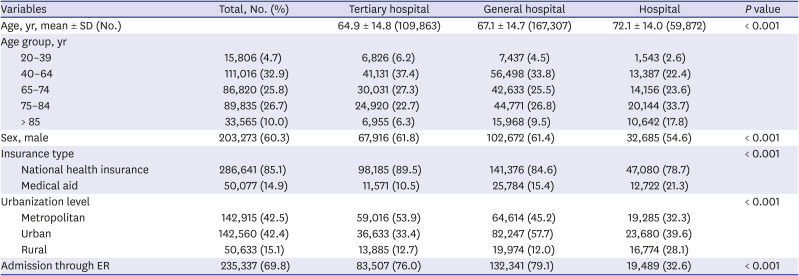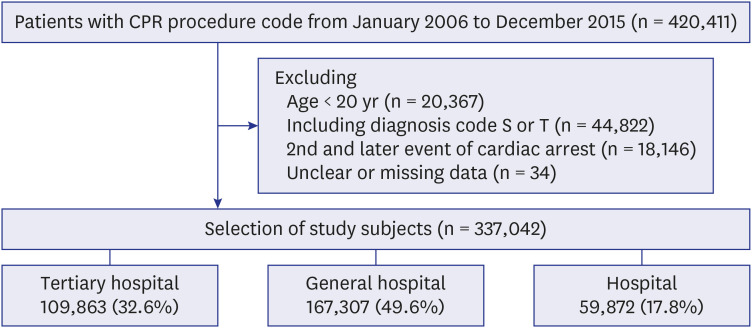1. Wong CX, Brown A, Lau DH, Chugh SS, Albert CM, Kalman JM, et al. Epidemiology of sudden cardiac death: global and regional perspectives. Heart Lung Circ. 2019; 28(1):6–14. PMID:
30482683.

2. Paratz ED, Rowsell L, Zentner D, Parsons S, Morgan N, Thompson T, et al. Cardiac arrest and sudden cardiac death registries: a systematic review of global coverage. Open Heart. 2020; 7(1):e001195. PMID:
32076566.

3. Nichol G, Thomas E, Callaway CW, Hedges J, Powell JL, Aufderheide TP, et al. Regional variation in out-of-hospital cardiac arrest incidence and outcome. JAMA. 2008; 300(12):1423–1431. PMID:
18812533.

4. Gräsner JT, Herlitz J, Tjelmeland IB, Wnent J, Masterson S, Lilja G, et al. European Resuscitation Council Guidelines 2021: epidemiology of cardiac arrest in Europe. Resuscitation. 2021; 161:61–79. PMID:
33773833.

6. Andersen LW, Holmberg MJ, Berg KM, Donnino MW, Granfeldt A. In-hospital cardiac arrest: a review. JAMA. 2019; 321(12):1200–1210. PMID:
30912843.
7. Andersen LW, Bivens MJ, Giberson T, Giberson B, Mottley JL, Gautam S, et al. The relationship between age and outcome in out-of-hospital cardiac arrest patients. Resuscitation. 2015; 94:49–54. PMID:
26044753.

8. Morrison LJ, Schmicker RH, Weisfeldt ML, Bigham BL, Berg RA, Topjian AA, et al. Effect of gender on outcome of out of hospital cardiac arrest in the Resuscitation Outcomes Consortium. Resuscitation. 2016; 100:76–81. PMID:
26705971.

9. Ro YS, Shin SD, Song KJ, Lee EJ, Kim JY, Ahn KO, et al. A trend in epidemiology and outcomes of out-of-hospital cardiac arrest by urbanization level: a nationwide observational study from 2006 to 2010 in South Korea. Resuscitation. 2013; 84(5):547–557. PMID:
23313428.

10. Nichol G, Thomas E, Callaway CW, Hedges J, Powell JL, Aufderheide TP, et al. Regional variation in out-of-hospital cardiac arrest incidence and outcome. JAMA. 2008; 300(12):1423–1431. PMID:
18812533.

11. Søholm H, Wachtell K, Nielsen SL, Bro-Jeppesen J, Pedersen F, Wanscher M, et al. Tertiary centres have improved survival compared to other hospitals in the Copenhagen area after out-of-hospital cardiac arrest. Resuscitation. 2013; 84(2):162–167. PMID:
22796541.

12. Carr BG, Kahn JM, Merchant RM, Kramer AA, Neumar RW. Inter-hospital variability in post-cardiac arrest mortality. Resuscitation. 2009; 80(1):30–34. PMID:
18952359.

13. Cudnik MT, Sasson C, Rea TD, Sayre MR, Zhang J, Bobrow BJ, et al. Increasing hospital volume is not associated with improved survival in out of hospital cardiac arrest of cardiac etiology. Resuscitation. 2012; 83(7):862–868. PMID:
22353637.

14. Yeung J, Matsuyama T, Bray J, Reynolds J, Skrifvars MB. Does care at a cardiac arrest centre improve outcome after out-of-hospital cardiac arrest? - a systematic review. Resuscitation. 2019; 137:102–115. PMID:
30779976.

15. Choi Y, Kwon IH, Jeong J, Chung J, Roh Y. Incidence of adult in-hospital cardiac arrest using national representative patient sample in Korea. Healthc Inform Res. 2016; 22(4):277–284. PMID:
27895959.

16. Cho HB, Lee JS, Lee CM, Jeong KY, Choi HS, Hong HP. Identifying out-of-hospital cardiac arrest patients by using International Classification of Diseases codes and procedure code. J Korean Soc Emerg Med. 2019; 30(1):8–15.
17. Charlson ME, Pompei P, Ales KL, MacKenzie CR. A new method of classifying prognostic comorbidity in longitudinal studies: development and validation. J Chronic Dis. 1987; 40(5):373–383. PMID:
3558716.

18. Wiberg S, Holmberg MJ, Donnino MW, Kjaergaard J, Hassager C, Witten L, et al. Age-dependent trends in survival after adult in-hospital cardiac arrest. Resuscitation. 2020; 151:189–196. PMID:
32246986.

19. Andrew E, Nehme Z, Bernard S, Smith K. The influence of comorbidity on survival and long-term outcomes after out-of-hospital cardiac arrest. Resuscitation. 2017; 110:42–47. PMID:
27816529.

20. Clarke SO, Schellenbaum GD, Rea TD. Socioeconomic status and survival from out-of-hospital cardiac arrest. Acad Emerg Med. 2005; 12(10):941–947. PMID:
16204138.

21. Reinier K, Stecker EC, Vickers C, Gunson K, Jui J, Chugh SS. Incidence of sudden cardiac arrest is higher in areas of low socioeconomic status: a prospective two year study in a large United States community. Resuscitation. 2006; 70(2):186–192. PMID:
16814445.

22. Nolan JP, Neumar RW, Adrie C, Aibiki M, Berg RA, Böttiger BW, et al. Post-cardiac arrest syndrome: epidemiology, pathophysiology, treatment, and prognostication. A Scientific Statement from the International Liaison Committee on Resuscitation; the American Heart Association Emergency Cardiovascular Care Committee; the Council on Cardiovascular Surgery and Anesthesia; the Council on Cardiopulmonary, Perioperative, and Critical Care; the Council on Clinical Cardiology; the Council on Stroke. Resuscitation. 2008; 79(3):350–379. PMID:
18963350.
23. Dumas F, White L, Stubbs BA, Cariou A, Rea TD. Long-term prognosis following resuscitation from out of hospital cardiac arrest: role of percutaneous coronary intervention and therapeutic hypothermia. J Am Coll Cardiol. 2012; 60(1):21–27. PMID:
22742398.
24. Kim SJ, Kim HJ, Lee HY, Ahn HS, Lee SW. Comparing extracorporeal cardiopulmonary resuscitation with conventional cardiopulmonary resuscitation: a meta-analysis. Resuscitation. 2016; 103:106–116. PMID:
26851058.

25. Donnino MW, Andersen LW, Berg KM, Reynolds JC, Nolan JP, Morley PT, et al. Temperature management after cardiac arrest. Circulation. 2015; 132(25):2448–2456. PMID:
26434495.

27. Nas J, Te Grotenhuis R, Bonnes JL, Furlaneto JM, van Royen N, Smeets JL, et al. Meta-analysis comparing cardiac arrest outcomes before and after resuscitation guideline updates. Am J Cardiol. 2020; 125(4):618–629. PMID:
31858970.

28. Carr BG, Goyal M, Band RA, Gaieski DF, Abella BS, Merchant RM, et al. A national analysis of the relationship between hospital factors and post-cardiac arrest mortality. Intensive Care Med. 2009; 35(3):505–511. PMID:
18936907.

29. Shin SD, Suh GJ, Ahn KO, Song KJ. Cardiopulmonary resuscitation outcome of out-of-hospital cardiac arrest in low-volume versus high-volume emergency departments: An observational study and propensity score matching analysis. Resuscitation. 2011; 82(1):32–39. PMID:
20951490.

30. Balian S, Buckler DG, Blewer AL, Bhardwaj A, Abella BS. CARES Surveillance Group. Variability in survival and post-cardiac arrest care following successful resuscitation from out-of-hospital cardiac arrest. Resuscitation. 2019; 137:78–86. PMID:
30771450.

31. Callaway CW, Schmicker R, Kampmeyer M, Powell J, Rea TD, Daya MR, et al. Receiving hospital characteristics associated with survival after out-of-hospital cardiac arrest. Resuscitation. 2010; 81(5):524–529. PMID:
20071070.

32. Stub D, Smith K, Bray JE, Bernard S, Duffy SJ, Kaye DM. Hospital characteristics are associated with patient outcomes following out-of-hospital cardiac arrest. Heart. 2011; 97(18):1489–1494. PMID:
21693477.

33. Høybye M, Stankovic N, Holmberg M, Christensen HC, Granfeldt A, Andersen LW. In-hospital vs. out-of-hospital cardiac arrest: patient characteristics and survival. Resuscitation. 2021; 158:157–165. PMID:
33221361.

34. Kokmen E, Özsarfati Y, Beard CM, O'Brien PC, Rocca WA. Impact of referral bias on clinical and epidemiological studies of Alzheimer's disease. J Clin Epidemiol. 1996; 49(1):79–83. PMID:
8598515.

35. Ballard DJ, Bryant SC, O'Brien PC, Smith DW, Pine MB, Cortese DA. Referral selection bias in the Medicare hospital mortality prediction model: are centers of referral for Medicare beneficiaries necessarily centers of excellence? Health Serv Res. 1994; 28(6):771–784. PMID:
8113057.










 PDF
PDF Citation
Citation Print
Print





 XML Download
XML Download